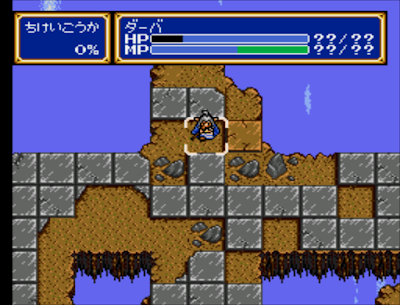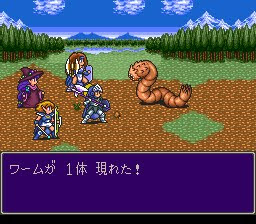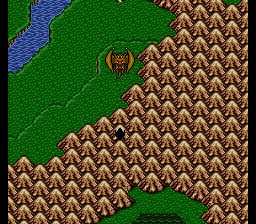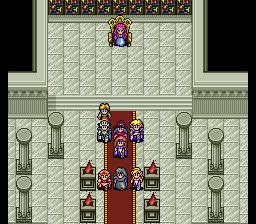Shin Momotaro Densetsu (新桃太郎伝説)
Released 12/14/1993, published by Hudsonsoft
This is the final game of 1993. It’s another entry in a series of games by Hudsonsoft, beginning with the 1987 Momotaro Densetsu for the Famicom. This one is apparently a remake of Momotaro Densetsu II for the PC Engine, thus a sequel to the original. The main character is based on the legendary Momotaro, or Peach Boy. The basic story is that an old man and woman who want children find a peach, and Peach Boy is born from it. When he grows up, he goes out to defeat demons that are troubling the area. Along the way he picks up three animal companions by giving them millet dumplings, and with their help he beats the demons.
The game begins after the first game, where Momotaro defeated King Enma, who then decided to try to bring love and friendship to the demon world. But King Basara, influenced by a demon Karla, decides to imprison Enma, and capture Princess Kaguya again. Momotaro goes to save her, but Basara’s sun Daida steals all of Momotaro’s equipment and powers, scattering them into 8 jewel parts around the world.
Momotaro wakes up in the old man and woman’s house, and he has to set out to try once again to defeat the demons and save Kaguya.
I was pretty disappointed by this game at first. This is the end of 1993. Final Fantasy VI comes out in four months. And this is what Shin Momotaro Densetsu looks like:
It’s basically an NES game. The interface is awkward, and there’s an 8 item limit (with no doubling of items). Using powers, like healing, require way too many menus and button presses — something that was common in earlier games but most developers have figured out by now. At least the damage numbers come up on screen instead of being communicated through text boxes. And in weapon shops you can exchange your weapons and armor for what they sell, seeing the numbers, so that’s nice.
Ginji, a swordsman, joins up as a friend — he has 4 different katanas that have different strengths or side abilities (e.g. healing after the attack).
By the way, the overworld is done with Mode 7 graphics and benefits greatly from bsnes’ recent “Hires Mode 7” feature — it looks a lot better at 720p.
The first thing we do is go see a Hermit. These are scattered throughout the game, and teach Momotaro his powers after fulfilling various conditions. For this one, you just have to beat him in a fight and get Kintan, the healing power.
The battle system, for the most part, is standard AMID. There is a system where the weather can change in battle, giving certain powers or monsters a boost or a nerf. Also Momotaro never kills the enemies, he こらしめるs them, which can be translated as “chasten” or “teach a lesson.”
Next up Momotaro frees some cave dwelling rats from monsters, and then gets the first of the 8 moon crystals. The next power, escape from dungeons, is past that. To get this, you have to escape from a cellar in 5 minutes via secret passages (if you fail you can try as much as you want).
Momotaro then has to make his way through a mountain, which has some nice graphics.
In this area you have to learn the thunder technique to get through the rocks that block your way.
Eventually Momotaro defeats a demon and rescues the bird, who joins the party if you give him a millet dumpling. The animal companions don’t fight directly. You feed them things you can find or buy, increasing their stats and teaching them different techniques, some of which are in battle, some out.
Next up is the Hanasaka Jiisan, although the demons destroy all of his flowers. When Momotaro defeats the main demon, Karla comes in and kills it, although a different horned demon seems to save him before he does so (this happens several times in successive boss battles).
After, the flowers are restored and the dog Pochi joins up, and in the next cave, the monkey (the last animal companion).
Next up in the traditional myths is Kintaro, who joins up on the adventure. He has various special attack moves that reduce his HP. In the next section Daida appears again but quickly leaves, frustrated at how weak Momotaro is.
After we beat Ryutoki, Karla once again kills him but he’s rescued by the mysterious figure.
Next up is Urashima Taro, who is kind of the priest/spellcaster of the party. This part is really annoying because (following the myth), Karla opens a box that ages your entire party. You already walk slowly in dungeons, and now you walk even slower — even with the speedup key on it’s pretty slow, I can’t imagine this on a real console.
This fight starts out hard but Urashima Taro comes in with the medicine to restore us to youth, and Karla is thwarted once again. Now underwater to save the Dragon King’s palace from the demons. This also provides a way to the moon, where Momotaro is given a mirror that shows the locations of the remaining Crystals.
The next goal is to go up to the snowy area. Karla sets up a set of puzzles/traps in the Oe Mountain — I don’t like puzzle solving with a bunch of random encounters, but that’s what you have to do. The boss in this area is Shuten Doji, who gives Momotaro the second moon crystal.
In the ice area, we go to the Netaro village, which I think is based on this legend. He’s asleep blocking the bridge to the next area, and Karla’s demons start attacking the town with ice.
The nearby ice tower has pegs that we need to cross using a hookshot given by the giant Dekataro.
The boss of this section is Princess Yasha. She joins the party after being defeated.
Now Dekataro gives us what we need to wake up Netaro.
This seems to be about a third of the game so it’s pretty long. It’s not bad, I just wish that they had put more effort into the interface to make it more like 1993 and less like 1989.










































